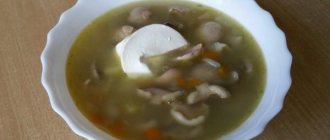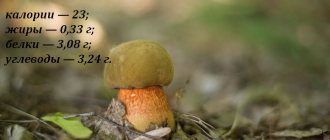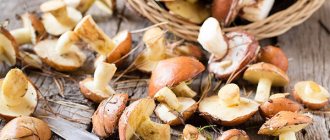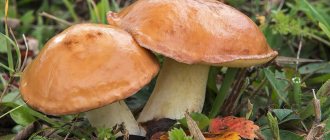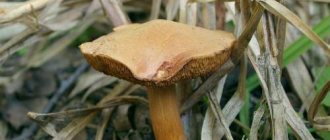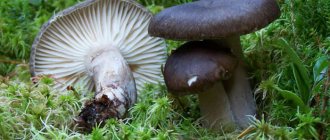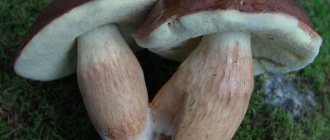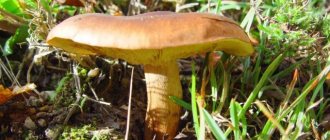hat
In mature representatives of the species, the diameter of the cap is from 5 to 10 cm. In young specimens, the cap is spherical, its edges are curved inward. Over time, this part of the mushroom straightens. The cap is usually light brown, but can also be orange or yellow. It is usually covered with scales.
The hymenophore or spore-bearing layer consists of small tubes and adheres to the stalk. Has a brown color. The skin of many mushrooms can be easily separated from the cap, but the yellow-brown butterdish is an exception. In inclement weather, this spore-bearing layer becomes sticky.
What can you cook
So, you went into the forest and collected a whole basket of yellow-brown moss. What to do with it next? What recipes can be prepared using this mushroom? In fact, their variety is enormous. Let's look at the best recipes.
Preparation
First, you need to prepare the mushrooms.
- To do this, you need to rinse them well under running cold water.
- Then, the legs are carefully separated from the caps using a sharp knife.
- Since the skin does not come off the mushroom easily, it is recommended to simply scrape it off with a knife.
- Then you need to thoroughly clean the bottom part of the cap. To do this, carefully cut out the spongy layer, and then wash the mushroom again. This is done so that when exposed to thermal agents, this layer does not ink and does not spoil the appearance of your dish.
- Afterwards the mushrooms should be boiled. To do this, they are immersed in boiling water and cooked for 20-30 minutes.
Soup from yellow-brown moss mushrooms
To prepare a delicious and rich soup you will need:
- chicken bouillon;
- boiled chicken meat;
- mushrooms;
- bulb onions;
- salt;
- sunflower oil;
- sour cream;
- garlic.
The stages of preparing the dish are as follows.
- First, prepare the chicken broth. Cut the boiled meat into small pieces and place in water.
- Strain the broth, pepper and salt to taste.
- Cut the onion into small cubes and the mushrooms into slices.
- Fry well in sunflower oil until golden brown.
- Chop the garlic and also fry along with the mushrooms.
- The resulting frying is added to the broth.
- The soup should simmer for 5 minutes, after which it is turned off.
Serve to the table.
Moss whistle in the oven
Another tasty, and most importantly, healthy dish that will not leave you indifferent.
You will need:
- about a kilogram of mushrooms;
- onion;
- vegetable oil;
- sour cream;
- Bay leaf;
- spices.
- Moss mushrooms are boiled in water for 20 minutes in advance.
- Then they need to be well cut into small medium-sized slices.
- The flywheels are placed in a preheated oven.
- Sprinkle olive oil on top.
- Pour sour cream on top.
- Salt, pepper, mix, sprinkle with onions.
- The mushrooms simmer in the oven for about half an hour.
Serve garnished with herbs.
Where does it grow
Yellow-brown oiler forms mycorrhiza with pine trees, which is why it can always be found in mixed forests of the Russian Federation. This mushroom grows both in the central part of the country and in Siberia and the Caucasus. Butterfly loves sandy soils and peat bogs. Often grows in groups.
The mushroom grows in July, the fruits are collected from August to October.
Interesting Facts
Swamp moss.
- Most types of butter are recommended to be cleaned before cooking, but for a yellow-brown butter dish this is too labor-intensive work. And its cap is not as sticky as other types, so the yellow-brown oil dish does not need to be cleaned.
- The spores of the oiler are yellow-brown, as well as the pulp, and turn blue when you press them.
- Instances of the yellow-brown oiler, growing in the forest, on sandy soils, are more fleshy, dense and tasty than their counterparts growing in peat bogs.
- In many regions ( Leningrad , Vologda region ), the yellow-brown oiler is often found en masse, in large families, or forms “witch rings.”
Doubles
The yellow-brown butterfly does not have poisonous counterparts, but in color and “stockiness” it is a little similar to the Gall mushroom. However, the spore-bearing layer of the dangerous fellow is white and may turn pink or not change color when cut.
The yellow-brown butterdish looks like a goat mushroom. But the latter is larger, and its cap is much lighter. Another difference is that the flesh of the goat turns red when cut.
Mushroom Kozlyak
This mushroom can also be confused with pepper buttercup. But the double has bright yellow flesh. This mushroom is inedible due to its pungent flesh.
Pepper oiler
The yellow-brown butterdish is often confused with the cedar butterdish. You can distinguish the double by its sticky cap and stem, which is covered with growths - warts that are white in color. In addition, the flesh of the false mushroom does not turn blue when broken.
Cedar oiler
The representative of the oilcan family is also similar to the red, fissured flywheel. But you can recognize the yellow-brown butterfly by the fact that it grows only under pine trees, while moss mushrooms can be found in any corner of the forest. In moss mushrooms, the hymenophores are much lighter than the outer side of the cap, and the spore-bearing layer of these mushrooms is more porous.
Red moss
Beneficial features
In addition to being edible, the mushroom has other beneficial properties, thanks to which it has become widely known and widespread. For example, these mushrooms, unlike their many counterparts, are low in calories. This means that if you closely monitor your weight and figure, you can easily include them in your diet and not be afraid that the extra pounds will return.
Yellow-brown flywheel contains a huge amount of useful amino acids. This means that in terms of the usefulness of its composition, this mushroom can compete with meat, while also saturating the body with useful substances. That’s why vegetarians hunt for the yellow-brown moss fly so much.
In addition to the above properties, it is worth noting that flywheel is rich in a huge amount of vitamins. For example, it contains vitamin D, which is vital for growth and activity. It contains exactly the same amount of it as regular butter.
In addition to vitamin D, it also contains a vitamin found in carrots. It has a good effect on the condition of the skin, teeth, hair and eyesight.
Also, the mushroom pulp contains a huge amount of useful enzymes and essential oils. They have a beneficial effect on a person’s appearance, and also speed up metabolism and improve digestion.
Do not forget about the content of the mushroom and B vitamins. They also contain folic and nicotinic acid.
Mushrooms are also used in pharmaceuticals because a very rare substance called “Molybdenum” was found in its composition. It has a beneficial effect on health and appearance, therefore it is included in various cosmetics.
Also, flywheel is a natural antibiotic that stops the development of various inflammatory processes. That is why since ancient times it has been boiled, dried, turned into powder and applied to wounds. It was believed that such powder stops inflammatory processes and heals the body.
Taste and nutritional value of flywheel
Moss mushroom is a mushroom whose energy value is low. Per 100 grams of product there are 19 calories, as well as 1.7 grams of protein, 0.7 grams of fat and one and a half grams of carbohydrates. The fruit body contains a large amount of vitamin A, as well as calcium, essential oils and enzymes that improve digestion.
Important! Moss fly contains a substance rare for food - molybdenum.
It is a natural source of antibiotics and has an additional effect on the body in the treatment of inflammatory processes in the body.
How to grow mushrooms yourself?
According to statistics, 75% of the population have a positive attitude towards various mushrooms, eat them, and some even sell them. Of course, such a high percentage of mushroom consumption is good from the point of view of further sales of finished products, because every 3 out of 4 people will buy these mushrooms for cooking at home.
You can grow moss mushrooms with your own hands.
Therefore, the chances of getting results from this business are quite real, but you need to work hard to achieve real success. To start growing mushrooms, you need to do the following:
- prepare a special container with the necessary filling - soil for feeding the mushrooms (here you can use wheat straw weighing 10-15 kg);
- prepare the mycelium itself (this is a special liquid for growing mushrooms);
- it is necessary to use ready-made blocks to start breeding mycelium;
- prepare a room for growing mycelium;
- fulfill all the necessary requirements to comply with the conditions for normal growth of mushrooms (high indoor humidity, good ventilation, normal lighting).
The ideal option for growing mushrooms is to use a greenhouse, the only disadvantage of which will be the high costs of heating and lighting. It will be best if you choose a room with large windows for this.
If you engage in growing mushrooms as a specific business, then after a short period of time it is quite possible to provide yourself and your family with a normal level of income and at the same time constantly develop your business.
Oiler red-red
Red-red oiler – lat. Suillus tridentinus
In another way, this mushroom is called Tridentine oiler or Trentian oiler.
Description
Mushroom cap
The diameter of the Tridentine Oiler hats is 50-150 mm. At a young age they have the shape of a hemisphere or pad, later they become more spread out and flat.
The hat is covered with a rough skin, dotted with many fibrous reddish-orange scales, arranged radially and giving the hat a cracked appearance. In rainy weather it becomes covered with mucus. The colors of the “headdresses” can be orange-yellow, pale orange, red-orange or red-brown. The older the Buttercan of Trentia, the darker the color of the hat. Occasionally, flaky pieces of white blankets remain on the edges of hats.
The caps are filled with tight, fleshy pulp of a yellowish, lemon-yellow, just yellow or yellow-brown hue. When damaged, it turns reddish.
The hat bottom consists of an adherent tubular layer of yellowish or orange-yellow tubes with large pores and torn edges, running down the legs. The pores have an irregular shape and are angular.
The red-red oiler reproduces by elongated yellowish-olive spores formed in olive-yellow or olive-brown spore powder.
